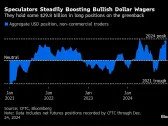The US dollar has experienced its strongest yearly advance in nearly a decade, driven by the solid US economy and President-elect Donald Trump’s tax-cut and tariff policies. This momentum is expected to continue into early next year, with analysts indicating that there is still room for growth.
A Decade of Strength: The US Dollar’s Yearly Advance
The Bloomberg Dollar Spot Index has risen 8% this year, marking the most significant increase since 2015. This surge in value has been attributed to the surprisingly resilient expansion, which has led traders to dial back expectations for how much the Federal Reserve will ease monetary policy.
A Cautionary Note from Fed Officials
Fed officials have signaled caution about further interest-rate reductions, breaking with other central banks that are expected to dial back rates more quickly. This development has given investors an incentive to shift cash to the US, pushing up the currency.
The Dollar’s Rise Against Major Peers
The dollar has advanced against all of its major peers in 2024, with the New Zealand dollar, Norwegian krone, and Japanese yen weakening the most against the US currency. This trend is expected to continue into early next year, with analysts predicting a further increase in value.
Market Players Increase Bets on Dollar’s Rise
A group of market players – including hedge funds and asset managers – have increased aggregate bets on the dollar’s rise to some $29.8 billion, according to data compiled by Bloomberg. This represents the most bullish positioning toward the US currency since April.
Doubts About Further Gains
However, there are also doubts about how much further the dollar will run, given the scale of its gains and the fact that the slower pace of interest-rate cuts is largely priced into the market.
A Mixed Outlook: Experts Weigh In
Jayati Bharadwaj, a currency strategist at TD Securities, said: ‘Many of Trump’s initial policies will be bullish for the dollar in early 2025. In the second half of next year, we expect the Fed to resume easing which can provide a pivot for the dollar strength, especially if other central banks are already on pause.’
On the other hand, Sarah Ying, head of currency strategy at CIBC Capital Markets in Toronto, said: ‘We are moderately bullish the greenback. Most of the Fed path is already priced in and we suspect dollar momentum should lose some steam in the second quarter.’
Market Prices Throughout
The market prices throughout this article have been updated to reflect the latest developments.
The Impact on Global Markets
The rise of the US dollar has significant implications for global markets. The stronger currency makes exports more expensive, which can lead to a decline in demand and a subsequent decrease in trade. This, in turn, can have a negative impact on economic growth and lead to a recession.
However, the dollar’s strength also makes imports cheaper, which can lead to an increase in consumption and investment. This can boost economic growth and lead to higher inflation.
The Role of Central Banks
Central banks play a crucial role in determining the value of currencies. They can influence interest rates, which can impact the demand for currencies. A lower interest rate can make a currency less attractive to investors, leading to a decrease in its value.
On the other hand, a higher interest rate can make a currency more attractive to investors, leading to an increase in its value. The Fed has signaled caution about further interest-rate reductions, breaking with other central banks that are expected to dial back rates more quickly.
The Impact on Businesses
The rise of the US dollar has significant implications for businesses. A stronger currency can make exports more expensive, which can lead to a decline in demand and a subsequent decrease in trade. This can have a negative impact on businesses, particularly those that rely heavily on exports.
However, the dollar’s strength also makes imports cheaper, which can lead to an increase in consumption and investment. This can boost economic growth and lead to higher inflation, making it more challenging for businesses to operate.
The Impact on Consumers
The rise of the US dollar has significant implications for consumers. A stronger currency can make imports cheaper, leading to an increase in consumption and investment. This can boost economic growth and lead to higher inflation, making it more challenging for consumers to afford goods and services.
However, the dollar’s strength also makes exports more expensive, which can lead to a decline in demand and a subsequent decrease in trade. This can have a negative impact on consumers, particularly those who rely heavily on imports.
Conclusion
The US dollar has surged to its strongest yearly advance in nearly a decade, driven by the solid US economy and President-elect Donald Trump’s tax-cut and tariff policies. Analysts predict that there is still room for growth into early next year, with some experts warning about the potential impact of the slower pace of interest-rate cuts.
The rise of the dollar has significant implications for global markets, businesses, and consumers. While it can boost economic growth and lead to higher inflation, it also makes exports more expensive, which can lead to a decline in demand and a subsequent decrease in trade.
As the market continues to evolve, it is essential for investors, businesses, and consumers to remain vigilant and adapt to the changing landscape.






